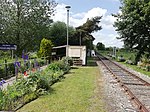Wymondham Junction railway station
East of England railway station stubsHeritage railway stations in NorfolkProposed railway stations in EnglandUse British English from December 2016Wymondham, Norfolk
Wymondham Junction railway station is a proposed railway station on the preserved heritage Mid-Norfolk Railway in the English county of Norfolk. The station is planned to be constructed just south of the adjacent Cemetery Lane level crossing close to the line's junction with the mainline Breckland Line. The proposed station site is near to the Breckland Line's Wymondham station, which is operated by Greater Anglia on the National Rail network, thus providing more convenient access for people wishing to visit the heritage railway than its current southern terminus, Wymondham Abbey.
Excerpt from the Wikipedia article Wymondham Junction railway station (License: CC BY-SA 3.0, Authors).Wymondham Junction railway station
Cemetery Lane, South Norfolk
Geographical coordinates (GPS) Address Nearby Places Show on map
Geographical coordinates (GPS)
| Latitude | Longitude |
|---|---|
| N 52.5653 ° | E 1.1127 ° |
Address
Cemetery Lane
NR18 0AF South Norfolk
England, United Kingdom
Open on Google Maps










